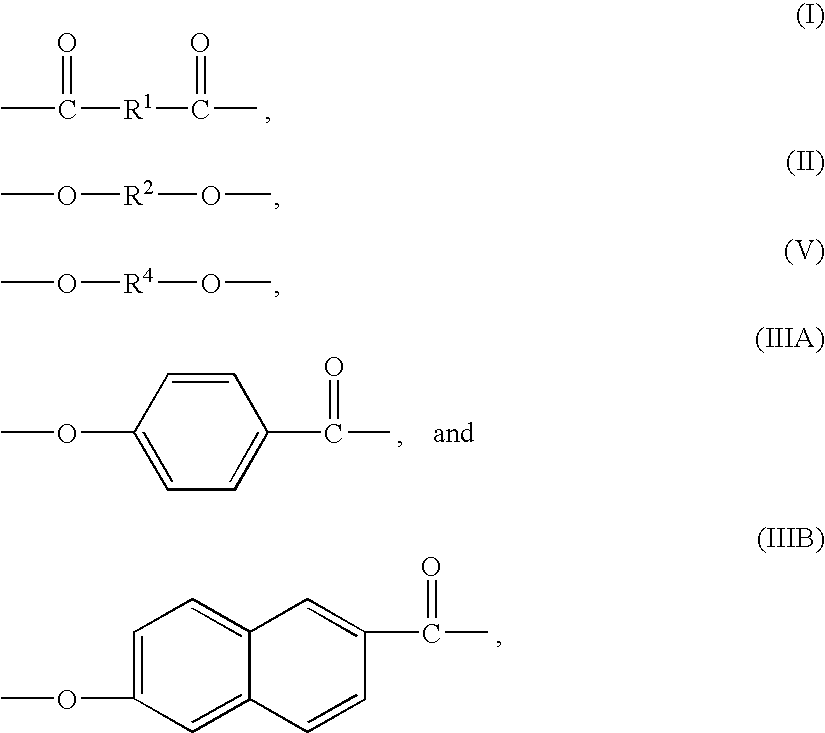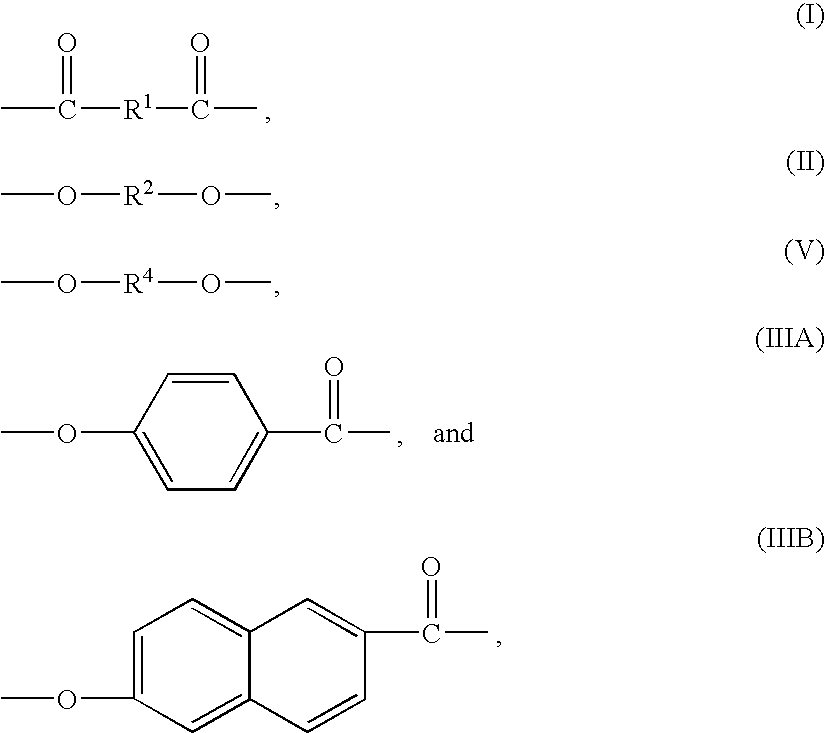Liquid crystalline polymers, processes for their manufacture, and articles thereof
a technology of liquid crystal polymers and processes, applied in the field of thermotropic liquid crystal polymers, can solve the problems of reducing the usefulness of films and containers in many packaging applications, introducing odor or undesirable flavors,
- Summary
- Abstract
- Description
- Claims
- Application Information
AI Technical Summary
Benefits of technology
Problems solved by technology
Method used
Image
Examples
example 1
[0157]p-Hydroxybenzoic acid (378.6 g), 315.8 g of poly(ethylene terephthalate), 20.4 g of 4,4′-biphenol, 206.3 g of hydroxy naphthoic acid, and 434.9 g of acetic anhydride were charged into an agitated 3-liter reaction vessel at room temperature. The agitator was of the helical ribbon type. The reaction vessel was fitted with a Vigreaux column and reflux splitter to permit removal of reaction byproduct. The mixture was deaerated three times under agitation by application of vacuum and refilling with nitrogen gas. The deaerated, agitated mixture was heated to reflux by raising a liquid metal bath whose temperature was set and held at 170° C. by external electric heaters. The refluxing mixture was held for one h under total reflux to permit the acetylation of all available hydroxyl groups in the ingredients. After one h, the temperature control set point on the liquid metal heating bath was raised 20° C. every 20 min until the set point was 300° C. During this period of increasing tem...
example 2
[0159]A similar polymer was made by the same general method as in Example 1. It had an Inherent Viscosity in 50 / 50 trifluoroacetic acid / dichloromethane (v / v) at 19° C. of 1.16 dl / g., its melt viscosity at 100 1 / s apparent shear was 2700 Pa-s at 190° C. and 380 Pa-s at 230° C. By DSC the resin had no melting endotherms between 20° C. and 350° C. This polymer is called polymer 2A herein.
[0160]In order to reduce the melt viscosity (molecular weight, see U.S. Pat. No. 6,294,618) this polymer was dry blended with 0.75% 4,4′-biphenol powder. The blend was fed into a 30-mm W&P trilobal extruder at 9 kg / hr. The screw was set to 150 rpm. The ten barrel sections were set at 250 to 280° C. in order to achieve a 300–315° C. melt temperature. The resulting polymer had an apparent viscosity at 100 1 / s apparent shear of 1300 Pa-s at 190° C. and 180 Pa-s at 230° C. It had an inherent viscosity of 0.97 dl / g. The polymer had a glass transition temperature (Tg) of 72° C. The polymer was anisotropic by...
example 3
[0161]Five-layer cast sheeting (a PP / AP / LCP / AP / PP sheet) was made from PP, AP, and Polymer 2B. Polymer 2B polymer was dried at 65° C. in air for 6 h prior to use. The resins were fed from single-screw extruders of 3.8-cm to 6.4-cm diameter at a total rate of about 70 kg / h. The PP and AP temperature set-points were 210° C. to 240° C. and 200° C. respectively. Polymer 2B was run at 195° C. The melt streams were joined in a 15-cm long neck with a 7.5-cm by 1.7-cm ellipsoidal cross section which tapered into a coat-hanger die 61-cm wide. The melt curtain (nominally 15-cm drop-length) ended in a nip between two quench rolls cooled with 21° C. water. Depending on takeoff speed the sheet thickness was varied from 600 to 750 μm. The thickness of the PP plus AP layers was 280 to 360 μm on one side and 230 to 300 μm on the opposite side. The layer of Polymer 2B in the sheet was 100 to 200 μm thick. The Polymer 2B layer was separated from the AP and PP for physical testing. Duplicate 2.54 cm w...
PUM
 Login to View More
Login to View More Abstract
Description
Claims
Application Information
 Login to View More
Login to View More - R&D
- Intellectual Property
- Life Sciences
- Materials
- Tech Scout
- Unparalleled Data Quality
- Higher Quality Content
- 60% Fewer Hallucinations
Browse by: Latest US Patents, China's latest patents, Technical Efficacy Thesaurus, Application Domain, Technology Topic, Popular Technical Reports.
© 2025 PatSnap. All rights reserved.Legal|Privacy policy|Modern Slavery Act Transparency Statement|Sitemap|About US| Contact US: help@patsnap.com



